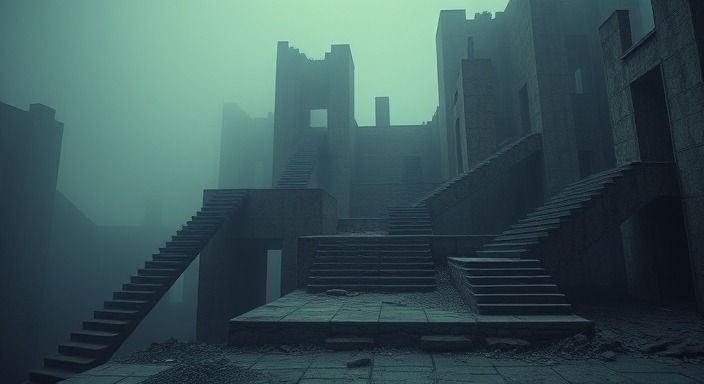
Trapped Inside the Box
There’s a new weirdness afoot in the world of horror, and it’s all about liminal spaces. Video games like Resident Evil and television series like “Severance” are popularizing the concept of limbo, or liminal purgatory. But there are some important books making waves in these spaces too, and I want to explore this niche genre.
Let’s start with some definitions. In the broadest terms, “liminal horror" refers to the concept of being trapped in-between places. What is "liminal" is meant to be transitory, or in a state of “passing through.” The horror element derives from being caught in this state of perpetual limbo, of being trapped in a place where one does not belong. Liminal horror is not truly limited to indoor spaces, but it's most fascinating application, in my opinion, exists in the impossible interior. Liminal horror opens a doorway to a fear that shouldn’t exist—the fear of being lost inside.
The genre taps into the idea of transitional spaces as a type of purgatory for wayward travelers. These are spaces whose defining characteristics are their lack of defining characteristics. Imagine drab corridors and windows that open into nothing, concrete stairs that spiral without end. The architecture is brutalist, industrial, minimalist; the architecture is simply wallpaper. These are places meant to be passed through. They are not meant to be noticed, let alone inhabited for any period of time.
But what happens when we enter one of these places and can’t leave? What happens when we find ourselves lost in a place where we don’t belong--in a place that was never intended for us?
The "horror" of the liminal arises from that uncomfortable feeling of "unbelonging"--the gradual sense of unmooring and vertigo. In a liminal space, shapes and dimensions lose their meaning. The space itself becomes a slippery reality whose boundaries lack any purchase or any point of reference. We find ourselves trapped with our restless thoughts. And we come to understand that, given endless time and endless tedium, madness is a certainty.
There are many famous examples of literature that tap into the liminal. Stephen King’s “The Langoliers” follows a group of travelers stranded in a deserted airport in a dimension eerily familiar to our own. More famously, “House of Leaves” by Mark Z. Danielewski explores the concept of impossible architecture as a roadmap for madness. In this disorienting novel, a family settles into a house of ever-shifting proportions, uncovering endless rooms and passages which defy the laws of physics.
Recently, I read an interesting novella by Sofia Ajram entitled “Coup de Grace.” Here the author takes a more metaphysical approach to the liminal, creating a Brutalist-style purgatory to trap her protagonist. Her unwitting hero is a suicidal man who has taken a train to the “end of the line” and stepped out into a space which should not exist. It’s a kind of endless train station, a waiting platform for travelers going nowhere. The station has drab and gray walls, empty rooms without purpose, and endless mazes of doors leading in circles. The very banality of this environment is meant to invoke a feeling of confinement and suffocation and dread. The space becomes a figurative straight jacket. The more we fight against it, the tighter it smothers our minds.
In her book, Ajram plays with both the concept of sensory deprivation and sensory depravation. There is no natural noise in this environment. And yet, something just doesn't sound right. This concept of audio dissonance is found in similar stories. In “The Langoliers,” for example, there’s an ominous high-pitched whir growing louder and louder, as some hidden horror approaches the airport. In “The House of Leaves,” there’s a low-pitched growling in the dark maze beneath the house. In “Coup de Grace,” there’s a maddening industrial hum, like an enormous ventilator filling the rooms with unsettling white noise. Always there is a feeling of restlessness, of a lack of peacefulness and serenity.
Let's take it one step further. I work in the field of medicine. I’ve long thought that hospitals are excellent grounds to explore the liminal. These houses of healing are by definition places of transit, where the sick are ferried back into the Land of the Well (...or lost in the night). Hospitals are not meant to be places where humans live. Those who spend inordinate amounts of time here will be the first to tell you about the feeling of being trapped in a restless, colorless limbo. One can imagine the drab and endless corridors. The fluorescent lights. The windowless rooms. The perpetual scent of antiseptic and human waste.It is a place of unresolved pain and never-ending uncertainty. Time loses its meaning, as the hospital never sleeps and never stops crawling along.
At the end of the day, all patients have a terror of being trapped in the hospital. They share the fear of entering this place and never leaving again. This is the very essence of liminal horror. We find ourselves in a place that we don't belong, and we come to realize there is no escape. We are not just trapped; we are lost forever.
*
(Author's post-note: Some other examples of liminal spaces that come to mind are paintings of M.C Escher; the Winchester Mystery House, with its doors and stairwells leading nowhere; video games like “Alan Wake 2” and “Silent Hill” and “Control”; the Apple television series “Severance,” and the movie “The Matrix.")
0 Comments Add a Comment?